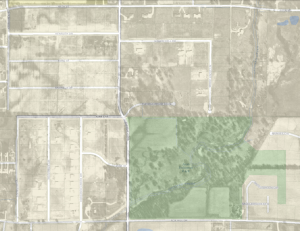by Kathryn Lyons
 Heading north on Grandview Drive from Fox Hill Drive you may notice a seemingly small, but busy park directly to the east. Juan Solomon Park is actually quite large, featuring 41 beautiful green acres. The park is equipped with several different amenities that invite neighborhood residents and other Indianapolis families to join in on the fun. These amenities include walking trails, a playground, tennis courts, a soccer field, a community room, and a picnic shelter. With all that the park has to offer, it is not surprising to see how popular it is for many citizens in the Indianapolis area.
Heading north on Grandview Drive from Fox Hill Drive you may notice a seemingly small, but busy park directly to the east. Juan Solomon Park is actually quite large, featuring 41 beautiful green acres. The park is equipped with several different amenities that invite neighborhood residents and other Indianapolis families to join in on the fun. These amenities include walking trails, a playground, tennis courts, a soccer field, a community room, and a picnic shelter. With all that the park has to offer, it is not surprising to see how popular it is for many citizens in the Indianapolis area.

In 1956 the future location of Juan Solomon Park was undeveloped forest and a small farm field. On the opposite side of Grandview Drive the first homes for Augusta Way were being built alongside the earliest homes in the immediate neighborhood.
The parkland was obtained in 1971, and in 1975 it was dedicated and named after Juan C. Solomon, an Indianapolis community leader who lived in the Grandview neighborhood with his wife Eloise at 6405 Grandview Drive. Juan Solomon was born in Macon, Georgia in 1908. His father Zollicoffer Cicero Solomon was a preacher (probably in the Colored Methodist Episcopal Church) and his mother Exa Walker was a lifelong teacher. Exa Walker taught at Beda Etta College in Macon in the 1920s and 1930, where her son Juan graduated in 1926. Beda Etta was opened by Minnie Lee Smith in 1921 to address the complete absence of African-American high schools in Macon. After World War II, Exa and her husband taught at the Memorial Trade School, a segregated trade school training African-American veterans, and Exa taught for several years at the Georgia Academy for the Blind, where she was teaching at her death in 1953. Continue reading